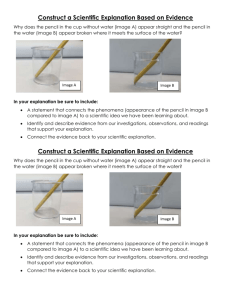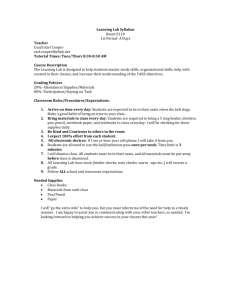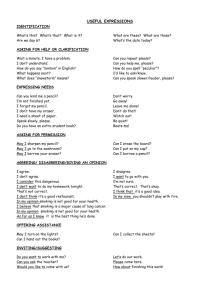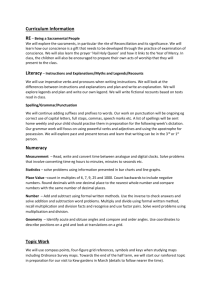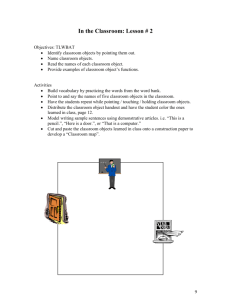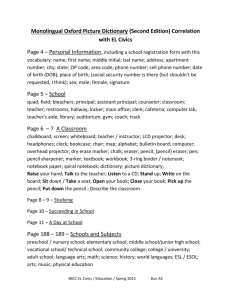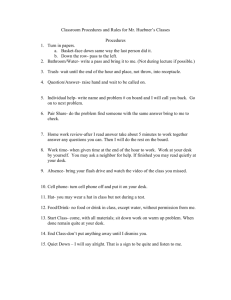The Object of Java Chapter 2 notes
advertisement
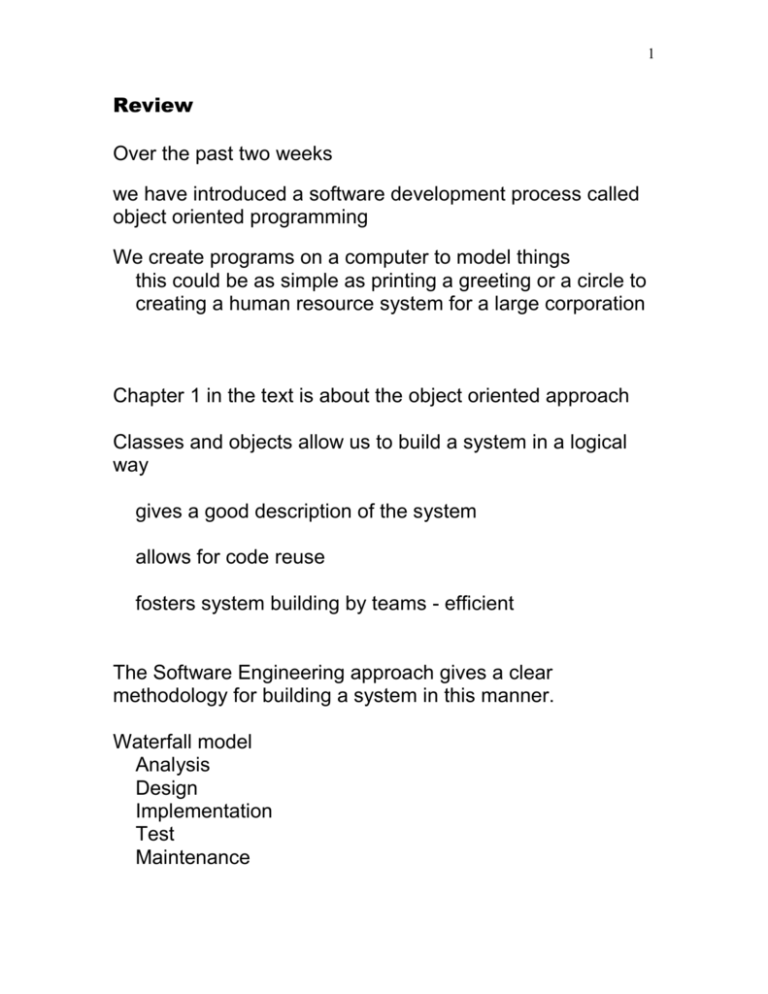
1
Review
Over the past two weeks
we have introduced a software development process called
object oriented programming
We create programs on a computer to model things
this could be as simple as printing a greeting or a circle to
creating a human resource system for a large corporation
Chapter 1 in the text is about the object oriented approach
Classes and objects allow us to build a system in a logical
way
gives a good description of the system
allows for code reuse
fosters system building by teams - efficient
The Software Engineering approach gives a clear
methodology for building a system in this manner.
Waterfall model
Analysis
Design
Implementation
Test
Maintenance
2
We have started to build our programming technical skills
What is the basic necessity for a program? – hello world
Code, compile, and run
What text editor do I use?
How do I compile a program?
How do I run a compiled program?
notepad, javac, and java
How can I improve my efficiency
enhance coding
find syntax errors quickly
test easily
reuse code – how did we do grayCircle
Integrated Development Environment
3
The Object of Java Chapter 2 notes
Objectives:
Introduce basic Java concepts necessary to write an initial
program in the form a class called Director
Syntax diagrams (section 2.1)
Describe syntax and semantics of a series of statements
Syntax and semantics of a parameterless method call
instruction
Syntax of an assignment instruction used to construct new
objects
Syntax and usage of instance variable declarations
Class specifications and method preconditions and
postconditions
Syntax of Java comments and their usage
4
2.1 Syntax Diagrams
Syntax (format) and Semantics (behavior or meaning)
Coding errors such as leaving out a semi colon are
syntax errors.
Run time errors such as not calculating an average
correctly are semantic errors
The use of blanks as separators is not usually understood.
2.2 The Method Call
Each object has a set of behaviors that are programmed
as methods.
e.g. a drawing pencil can move forward and turn, etc
object reference . method name ( ) ;
e.g.
pencil.moveForward();
Constructors fall into this category
DrawingTool()
Executing a method is sometimes known as sending a
message to the object.
5
2.3 Instruction Sequences
Normally called statement sequences or statements in the
Java program
Unless there is a branch, statements are executed in a
sequential manner.
Will use a drawing tool in the next lab in a sequence to
create a picture.
2.4 Constructing and Assigning Objects
An object of a particular class must be created, instantiated,
or constructed before it can be used.
The format of the instantiation is
new ConstructorName()
In particular, the constructor name is the class name. e.g.
new DrawingTool()
In order to associate a newly constructed object with a
name, an assignment statement or instruction is used.
Variable = Expression;
Assignment Instruction assigns or binds a variable name to
the result of an expression evaluation.
6
Full method for creating and instantiating an object is
developed using sections 2.4 and 2.6.
Every Java variable must be declared before it can be
used. (and then initialized)
private DrawingTool pencil;
// line 1
declares pencil of type DrawingTool. You then instantiate
it with
pencil = new DrawingTool();
// line 2
This can be done in one line.
There are various problems that can occur with unbound and
the process of binding variables.
After the execution of line 1, pencil has a null value.
Using it then, before line 2 would cause a
NullPointerException.
Consider
private DrawingTool pen;
pen = new DrawingTool();
pencil = pen;
This results in pen and pencil pointing to the same storage
location. They are both aliases for each other.
7
pen = new DrawingTool();
pencil = new DrawingTool();
pencil = pen;
This results in the object that pencil originally pointed to
becoming an orphan.
Can’t access it again, Java VM will recover the space.
pencil = new DrawingTool();
pencil = new DrawingTool();
This creates and orphan, and so does
pencil = new DrawingTool();
pencil = null;
Not a good practice
2.5 Swapping
This routine is a classic that illustrates the need for
temporary storage.
temp = pen;
pen = pencil;
pencil = temp;
Usually created as a helper method within a class.
8
2.6 Putting It Together in a Java Class
Instance variables are declared as part of a class
declaration. The values can vary from one class
instantiation to the next.
private DrawingTool pencil;
(The difficult part is that there are also class variables that do
not vary from instantiation to instantiation.)
Declare the variable,
Instantiate the variable, and
Bind or initialize the variable.
Figure 2.11 as an example of a Director Class. This is run
with a go class.
// Author: Riley -- May, 2000
public class go {
public static void main(String args[])
Director director = new Director();
}
}
{
9
2.7 Programming by Contract
A class invariant defines a collection of facts that are true
about class objects:
A DrawingTool object appears as an arrow within the
DrawingCanvas window. (Window is 200 pixels wide, 150
pixels high.)
I expect you to use a postcondition and possibly a
precondition for each method that you write.
We will practice this in the upcoming lab.
The Precondition/Postcondition Contract:
If the calling code ensures the precondition is true at the
time it calls the method,
then the postcodition is guaranteed to be true at the time
the method completes.
2.8 Comments
Comments are signaled by a line beginning with // or
a block beginning with /* and ending with */
Comments are a major way of documenting your program
10
COMMENTS // OR /* */
At the beginning of every class a comment to indicate the
Author
Date
Other identifiers
Throughout the class to provide specifications,
(class invariants, preconditions, and postconditions).
Any place the code might otherwise be confusing.
